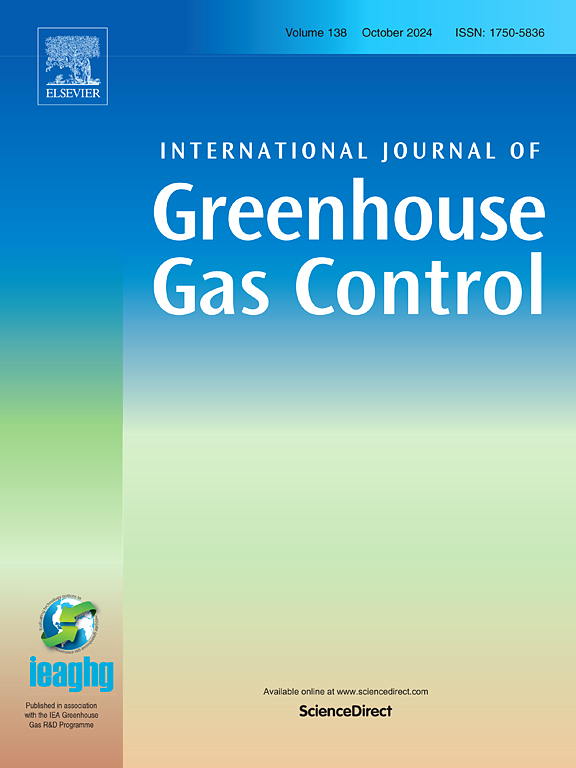利用主动和被动数据对 CCS 进行地震监测:基于澳大利亚鹈鹕场址的合成可行性研究
IF 4.6
3区 工程技术
Q2 ENERGY & FUELS
International Journal of Greenhouse Gas Control
Pub Date : 2024-11-01
DOI:10.1016/j.ijggc.2024.104277
引用次数: 0
摘要
碳捕集与封存(CCS)预计将在二氧化碳减排方面发挥重要作用。成本效益高且简化的监测对于 CCS 的快速应用和发展至关重要。地震成像方法经常被用来监测二氧化碳注入地下产生的低速异常。在本研究中,我们根据澳大利亚吉普斯兰盆地鹈鹕封存场的地质约束地下模型,生成了二氧化碳注入地下不同阶段的主动和被动合成地震数据集。我们将全波形反演(FWI)和波方程频散(WD)反演应用于海底部署的分布式声学传感(DAS)数据,以重建低速异常。我们为该研究的主动数据部分建立了应变(DAS)和位移数据集模型,结果表明它们能够重建类似的二氧化碳异常。基于 FWI 的活动数据延时成像可产生最精确的结果。不过,这种方法成本高昂,而且由于储藏点位于近岸,因此存在复杂性问题。另一种方法是对被动数据进行反演,结果差异不大,但仍能有效监测地下的变化,并有助于监测储层深处的二氧化碳羽流。此外,我们还展示了 WD 反演环境噪声产生的肖尔特波的能力,以便在万一发生泄漏的情况下对二氧化碳进行浅层探测。因此,我们提出了一种混合模式监测战略,即在日常监测中使用被动数据,而只有在需要进一步调查时才部署主动勘测。本文章由计算机程序翻译,如有差异,请以英文原文为准。
Seismic monitoring of CCS with active and passive data: A synthetic feasibility study based on Pelican site, Australia
Carbon capture and storage (CCS) is forecast to play a significant role towards CO emissions reduction. Cost-effective and simplified monitoring will be essential for rapid adoption and growth of CCS. Seismic imaging methods are regularly utilized to monitor low-velocity anomalies generated by injection of CO in the subsurface. In this study we generate active and passive synthetic seismic datasets at different stages of CO injection in the subsurface based on geologically constrained subsurface models of the Pelican storage site in the Gippsland Basin, Australia. We apply full waveform inversion (FWI) and wave-equation dispersion (WD) inversion to seafloor deployed distributed acoustic sensing (DAS) data to reconstruct the low-velocity anomalies. We model both strain (DAS) and displacement datasets for the active data component of the study and show that they result in similar reconstruction of the CO anomaly. FWI based time-lapse imaging of active data yields the most accurate results. However, this approach is expensive and also suffers from complex issues because of the near-onshore location of the storage site. Alternatively inverting passive data results in only minor differences, but can still effectively monitor changes in the subsurface, and assist in monitoring the CO plume at the reservoir depth. Furthermore, we demonstrate the capability of WD for inverting Scholte-waves derived from ambient noise for shallow detection of CO in the unlikely event of a leakage. Therefore, we propose a mixed mode monitoring strategy where passive data is utilized for routine monitoring while active surveys are deployed only when further investigation is required.
求助全文
通过发布文献求助,成功后即可免费获取论文全文。
去求助
来源期刊
CiteScore
9.20
自引率
10.30%
发文量
199
审稿时长
4.8 months
期刊介绍:
The International Journal of Greenhouse Gas Control is a peer reviewed journal focusing on scientific and engineering developments in greenhouse gas control through capture and storage at large stationary emitters in the power sector and in other major resource, manufacturing and production industries. The Journal covers all greenhouse gas emissions within the power and industrial sectors, and comprises both technical and non-technical related literature in one volume. Original research, review and comments papers are included.

 求助内容:
求助内容: 应助结果提醒方式:
应助结果提醒方式:


